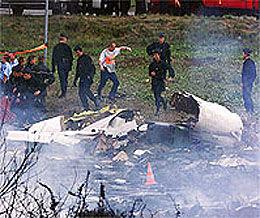
Air France Concord Goes Down
July 25, 2000, Air France Concorde flight AF4590, crashed on take-off from Paris-Charles de Gaulle airport at 4:44 p.m. today. The Concord was caring 100 passengers, 9 cabin and cockpit crew. The aircraft departed with a destination to John F. Kennedy International Airport in New York. All onboard as well as 4 persons on the ground were killed. The aircraft cashed into a nearby hotel.
The cockpit-voice recorder indicated the tower had informed the captain he had flames shooting out of the port side of the jet. The captained radioed back he had engine failure to number 2 engine on the left side of the jet closest to the fuselage, was unable to raise the landing gear. The controllers advised the captain he had cleared all traffic and he was cleared to maneuver the jet. The Concord was unable to gain altitude, it banked to the left then crashed.As the plane rotated off the runway, number 2 engine left side became sluggish however within monents it returned to normal function, then number 2 enine lost power a second time about a minute into the flight. It was at that point, investigators said, that the plane stalled then banked to the left and then crashed.
Flight AF 4590 was scheduled for departure from Paris at 3 :25 PM local time. The aircraft left the parking space at 4.31 PM, an hour and 6 minutes late. There were two reasons for this delay. During the earlier return flight from New york (JFK) on 24 July for this aircraft, the captain reported the number 2 engine reverse thrusters were not operational. The spare part for the reverse thruster was not available in the parts warehouse. However, given the technical tolerance authorized by the manufacturer, the aircraft could take off again without being repaired. This information was presented to the captain of Flight AF 4590 The captain made the decision to have the spare part changed. The spare part was immediately obtained from another spare Concorde (it took 30 minutes to make the necessary repairs).
The 100 passengers on this special flight had very short connections at Paris-Charles de Gaulle Airport, and were all carrying luggage. Due to the late arrival of some of the luggage from the connecting flights, the Concorde was delayed even further. Only after the spare part was replaced and the luggage loaded did the captain make the decision to depart. It has been reported that on takeoff the jet blew a tire. This is not the first time that the Concord had experienced a blown tire on takeoff. Several months back, the Concord blew a tire and pieces of tire broke up and ripped into the fuel tank. The Concordes has a history of blowing tires on takeoff and landing and debris from which damage has been caused to engines, fuel tanks, hydraulic systems and wiring.
Investigators will be looking at the possibility that a blown tire may have occurred and the possibility that the cause of the Concord going down was directly related to this. The Concord has a length of 203 feet with a wingspan of 82 feet. The concord can carry up to 100 passengers and its cruising altitude is 53,136 ft. The passengers consisted of 96 German, 2 Danish, 1 American and Austrian. The aircraft registration number F-BTSC, the owner: Air France, date of entry into service: 23 October 1980, type of engine: Rolls Royce Olympus 593, number of hours flown: 11,989, number of landings: 3,978, last A check: 21/7/2000, last major overhaul: 4/28/2000, and this aircraft had no microscopic cracks.


